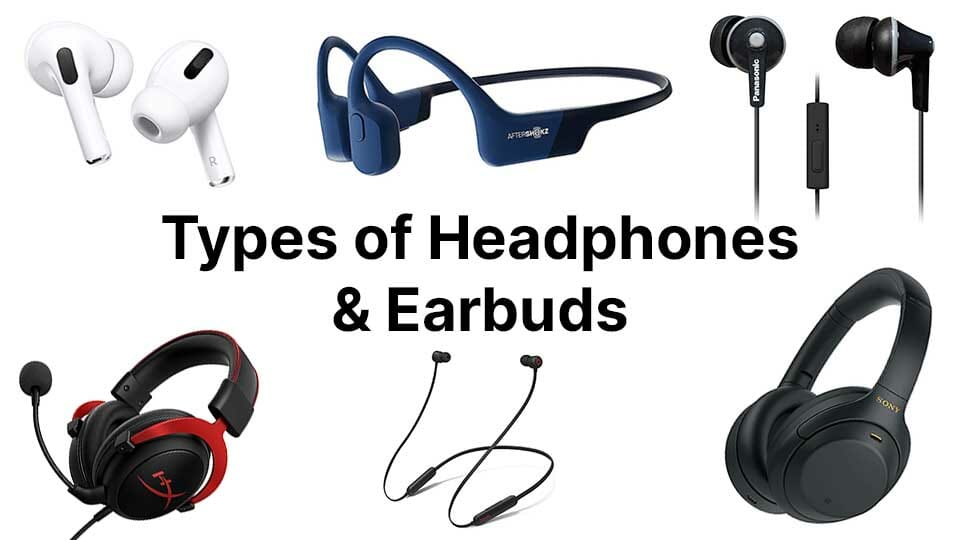What Types of Headphones Are There?

OVER-EAR, ON-EAR, IN-EAR: WHAT TYPE OF HEADPHONES ARE YOU?
When looking for the perfect headphones, you will come across different types of headphones. In order to find the perfect headphones for you, you should get to the heart of your own idea of wearing comfort, everyday handling, visual appearance, but also sound preference. Not only tastes and preferences are different, every person also has an individual hearing sensitivity.
Should I use circumaural (over-ear), supra-aural (on-ear) or in-ear headphones? Do I need closed, open or semi-open headphones? These – and probably more – questions are often asked before buying headphones for the first time.
What exactly is the difference between these headphone models and what purpose are they particularly suitable for? We want to take a quick look at this with this headphone guide.
Over-Ear – Headphones
Over-ear headphones enclose the entire ear and lie flat, comfortably with their ear cushions on the head instead of on the ear. The pressure from the temples and ear pads is distributed more comfortably.
Over-ear headphones are definitely the right candidates for stationary, high-quality listening pleasure on the music system in your own four walls, dedicated headphone amplifiers, mobile headphone amplifiers in hotels or on long-haul flights.
But circumaural headphones are also the first choice for use in the recording studio, during recording sessions by YouTubers or if you want to follow the series marathon on Netflix late at night.
So if you focus on uncompromising sound and comfort and really want to experience and enjoy music, you can certainly pass as an over-ear type.
On-Ear Headphones
On-ear headphones appear as a “both and” solution and are recommended for demanding listening sessions at home and on the go, or basically in all situations.
Due to their uncomplicated handling and their lower space requirements, especially when high-quality sound and mobility play a central role, they quickly become a constant companion. On-ear headphones lie directly on the ear, but are more compact and lighter than circumaural headphones, which are primarily designed for home use.
So if you prefer to listen to music spontaneously and everywhere, on the way to work or when traveling in the hotel, you can reach your destination carefree with on-ears.
In-Ear Headphones
In contrast to circumaural and supra-aural headphone models, in -ears are inserted directly into the auditory canal and are considered the smallest type of headphone.
When the in-ear headphones are properly seated in the ear canal, the distance between the eardrum and the membrane in the headphones is closed and very small. Thus, only little energy has to be applied through the membrane to achieve a good volume.
If you are looking for easy-to-carry and space-saving headphones for on the go, for sports, for working or playing games in between, or just for listening to music on your daily commute, you can turn to the mobile headphone variant, the in-ear. Despite their small size, in-ears can provide enormous sound performance.
In-ears are available in different models – which exactly and how they differ, we have explained in our blog post Which in-ear headphones are there? compiled.
Whether over-ear, on-ear or in-ear headphones, they all have in common that they can be designed according to the closed, open or semi-open principle. This affects both the sound and its intended use.
Let’s take a closer look at the acoustic construction of the headphones:
Closed Headphones
Closed -design headphones shield external noise with their ear pads especially Razer Kraken V3 X (Black) and their closed auricles and at the same time do not allow music to leak out.
Ideal for at home in peace and quiet, but also advantageous when you are dealing with many people in a small space, be it on the bus or train, in the university auditorium or with noise-sensitive roommates.
In the studio when recording vocals, closed headphone models are also used, since otherwise the sound emitted to the outside would be scattered back into the microphone in an undesirable manner.
Open Headphones
Open headphones let those around you know pretty much exactly at what volume you are listening to music and, above all, what the musical playlist is currently playing. On the other hand, they also allow the heat that inevitably develops between the ear and the auricle to escape, thus enabling longer and pleasant listening sessions.
Open-design headphone models are particularly recommended when the sound emitted by the headphones is irrelevant. An open design is therefore ideal for at home, where you can experience an enormously open and spatial sound image to the fullest – without any unwanted overhears, which closed models cannot offer.
Half Open Headphones
Half-open headphones try to combine the advantages of the construction principles already mentioned. In this way, they allow low frequencies, which are not quite as disturbing, to escape almost unhindered. High frequencies are dampened on the inside and are softened when they reach the outside.
The same applies to the increase in temperature around the ear, so that it can be worn comfortably for longer periods of time. On the one hand, they sound very spatial, can be silky soft and finely resolved, but also powerful in the low frequency range.
Conclusion
Whether for sports, on the go, for ambitious hi-fi enjoyment or as a work tool in the studio – you will find headphones for every application that have their particular strengths. Ultimately, it’s up to you to decide what you want from your headphones.
In addition to the basic decision regarding the construction of the headphones, other factors such as the type of connection, active or passive noise cancellation, integrated microphone or the possibility of detaching the handset cable will influence the choice of your headphones.